SOUTHERN FRANCE, IN SCENT AND SIGHT
Heaven Scent Flower
I trace the origin of my present obsession with growing carnations – big, fat, fragrant carnations (Dianthus caryophyllus) – to the movie, Jean de Florette, that I saw back in 1986. Not that I aspire to labor under the weight of hauling water long distances to care for my plants, as did Ugolin. And not that I’m hoping to get good money selling the cut flowers at a local market.
Actually, my only memories of the film are of the charming countryside of Provence, of Ugolin crouching over the plants and lavishing them with care, and of the pretty pink flowers. Come to think of it, I’m not sure Ugolin’s carnations even got as far as the flowering stage. Anyway, in my mind’s eye I see those pink blossoms and smell their spicy perfume.
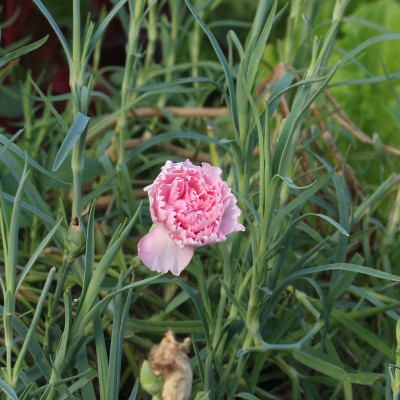
With good soil and ample water, my carnations have an easier time of it that did Ugolin’s. Too easy, perhaps. Carnations don’t need or like overly rich or wet soil. When it came time to plant out my seedlings, I recalled those scenes in Jean de Florette. The ledge of soil held up by a stone retaining wall along the south side of my house provide the good soil drainage and sunlight that suits carnations. Lavender, another Mediterranean plant growing on a wall nearby, will help make the carnations feel right at home.
The biggest threat to my carnations is winter cold and wetness. And even then, these carnations, although technically perennials, are typically short-live perennials that peter out after a couple of years. Luckily, they are easy to grow from seed or root from cuttings.
Like Ugolin, I’ll soon be carefully nurturing some new seedlings. Whether planting, picking, taking cuttings, or preparing them for winter, I’ll also be hunched over my carnations and lavishing them with care, in the months ahead. It’s worth it, for the pastel flowers, and especially for the flowers’ heavenly scent.
And Some Things for the Other Senses
What’s the attraction of southern Europe? The climate there is so different from here in the Wallkill River valley, yet I am attracted to and keep trying to grow Mediterranean plants such as carnations, figs, pomegranates, lavender, black mulberry, and rosemary. All these plants thrive in dry summers and cool, not frigid, winters; minus 20°F is not an uncommon low winter temperature here.
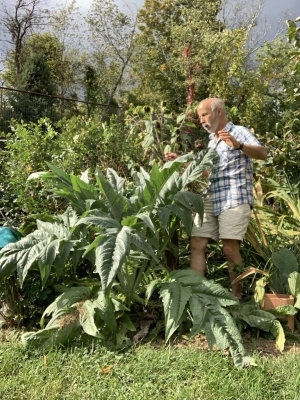
Cardoon, last year
Add to the roster here artichoke and cardoon, two more Mediterranean plants that I set out last spring, for the artichoke, the spring before for the cardoon. (The very mild temperatures of the previous winter let the cardoons survive their first winter outdoors.) That was after sowing each plant in later summer and having it winter in the very cool temperatures of my greenhouse, which provided the vernalization the plants need to flower their first season outdoors.
Both cardoon and artichoke grow as a whorl of spiny leaves from the center of which rises a main flower stalk with smaller flower stalks branching off lower down. Like carnations, they are short-lived perennials. Like carnations, they are easily propagated, in this case by seed or by offshoots that grow at the base of the plant
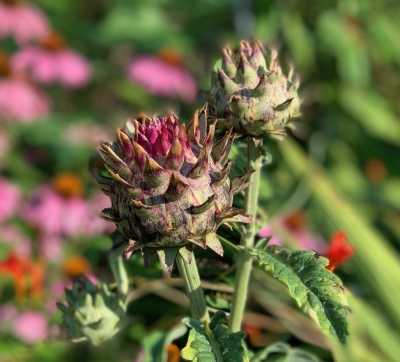
Cardoon in bud
Like carnations, the biggest threat to artichokes and cardoons around here is winter wetness and, especially, cold. Winter cold will assuredly kill them unless they are protected in some way. To that end, late last fall, I cut down the plants and covered each with a large, inverted flowerpot in which and on which piled leaves for insulation.
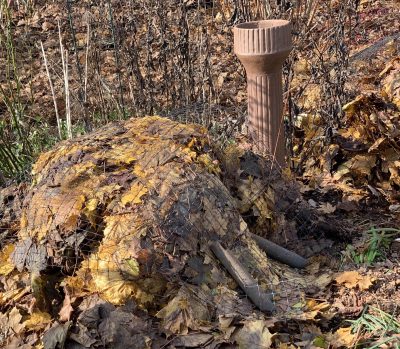
Cardoon & artichoke protected for winter
During the warm spell a week or so ago, I pulled back the leaves and uncovered the plants. Cardoon leaves had sprouted more than a foot high within their winter home! Without light, the leafy stalks were ghostly white.

Cardoon, after winter
That’s okay; cardoon is sometimes purposely blanched to make its flavor more mild. A few days of light will green them up. That’s okay too; I’m growing cardoon for its bold visual presence — last year the plants leaves formed a 3-foot-high, blue-green, mound of spiny leaves up the center of which rose flower stalks at the top of which opened blue flowers resembling enormous thistles.
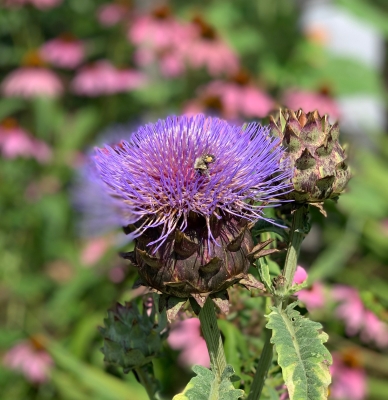
Cardoon flower
As for the artichokes: Not a sign of life. Perhaps winter cold or moisture did them in. Perhaps mice lunched on the roots. Perhaps there’s life beneath the ground, still to awaken. I’ll keep my fingers crossed.

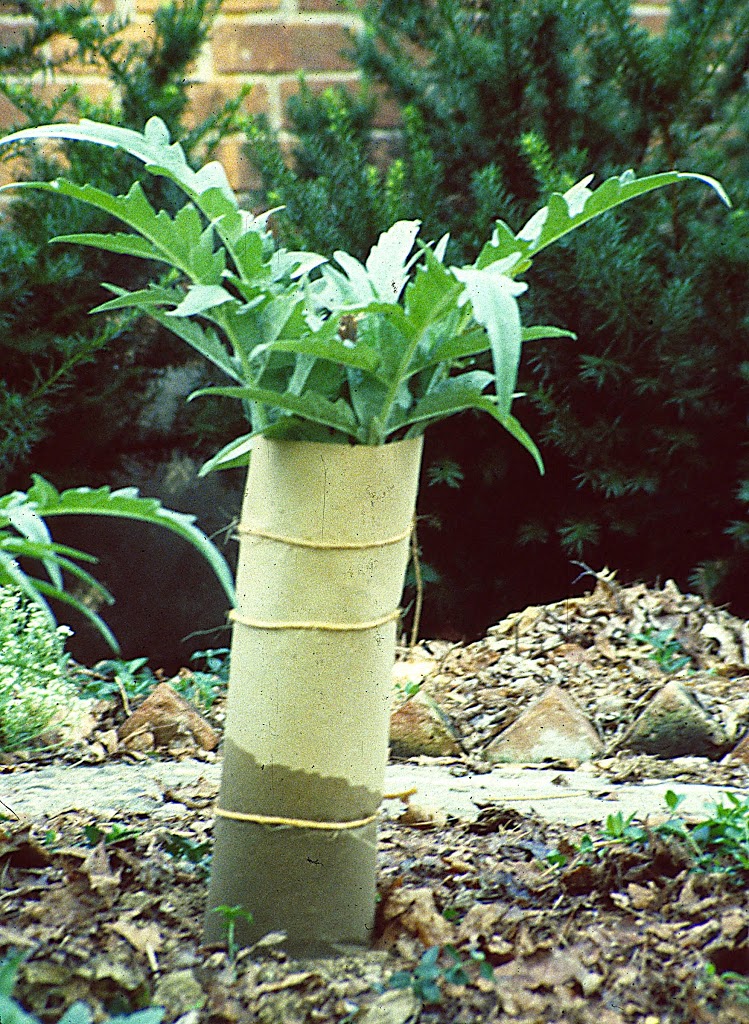
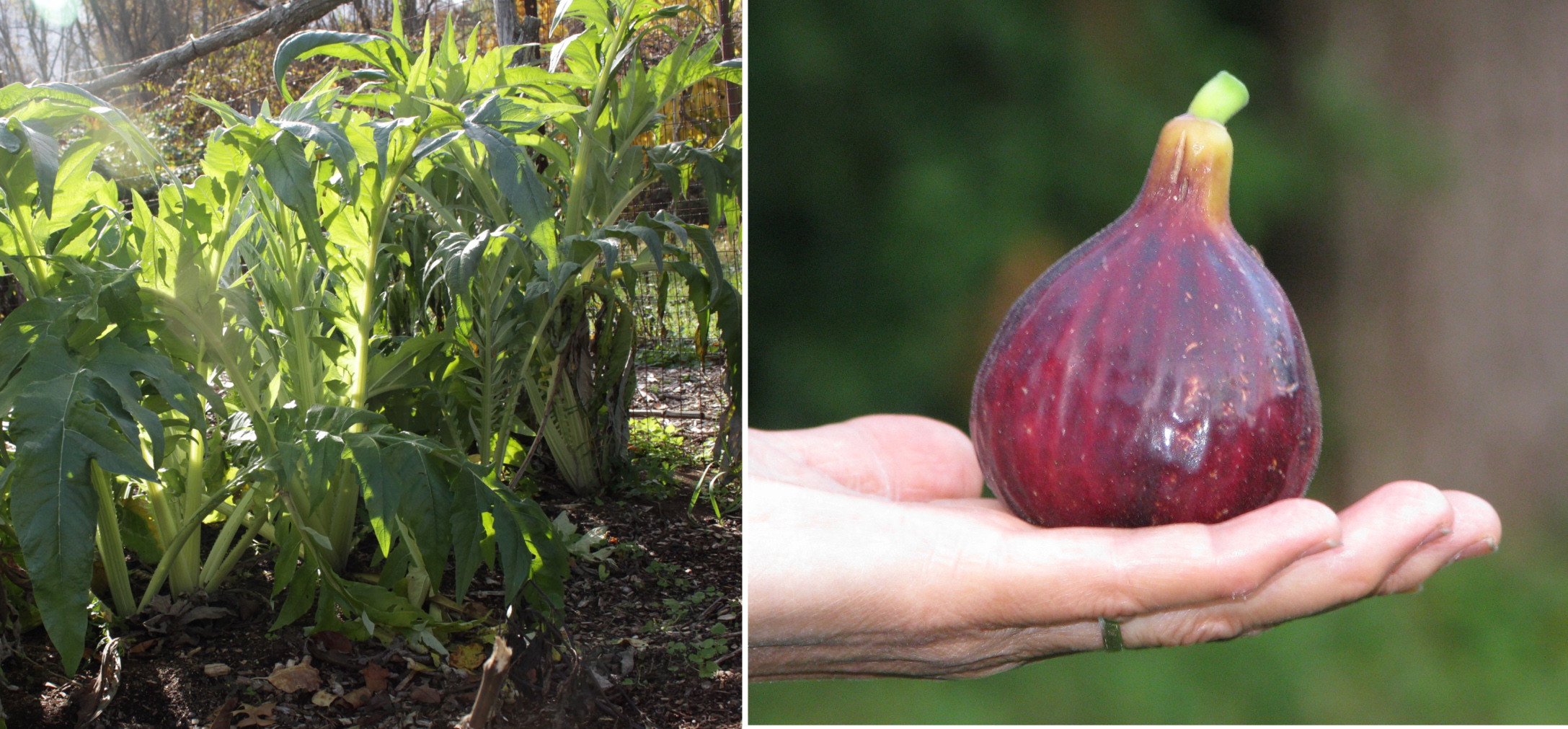

Dear Lee, I find your blog fascinating , so informative yet personal . I can feel your joy through your words.
Crossing my fingers for the ressurection of the Artichoke.
Best regards from Israel
Hi Hava. I now fear the worst for the artichoke. It looks like cardoon, though closely related, is more reliably cold-hardy here. I’m not totally giving up on artichoke, though. I have one more plant that overwintered in the cool temperature greenhouse. I’ll plant it out when the weather warms and pay greater attention to better drainage and, in late fall, better winter protection.
Hi Lee:
The parts of this post regarding over-wintering Cardoon have spurred me to write to you. I am interested in the nutritional benefits of Moringa and have been wondering if you know of any efforts to grow this tropical tree, which is native to tropical hardiness zones 9 & 10, in the Northeast. I live in central NH’S hardiness zone 5b and realize it would take very significant, extraordinary efforts to prepare Moringa for our cold season. Have you heard of anyone trying?
I recently bought your book on pruning and joined your webinar on the topic earlier this week. Thank you for both.
Jerry
Tropical plants take too much heat and light for Zone 5b. It’s not impossible, but to me seems like an excessive use of energy to provide that heat and light.
Too bad this post is not Pinterest capable.
I’m not very “fluent” in social media and would post it on Pinterest if I knew how. Anyone out there want to tutor me in Pinterest? (Or Instagram?)
Ah, finally plants I can relate to. Here in Carmel Valley (9b) – near Monterey CA – we have the ideal conditions for artichokes and the like. Most of the US crop of artichokes is grown along the Central Coast and in the adjacent Salinas Valley, all within a 30 minute drive. Interestingly enough, hardly anyone around here grows artichokes for their ornamental value. After seeing your example, I’m going to give cardoons a try.
What a wonderful tale of hope and resilience! That’s what I feel gardening is all about. Sometimes I think a plant has “bought the farm” (pun certainly intended ;-)) but get busy and forget to remove it only to find a month or even a season later that the plant is still alive!! I’m hoping that’s the case with my rhubarb that I planted early last spring. So far, only one plant (of 6) has shown itself above ground and I’m hoping that the roots survived the unusually (for us here in Central Jersey) snowy winter… time will tell.
Neither zone 6 winter nor snow should present any problem for rhubarb. If it doesn’t come back, something else must be the cause.